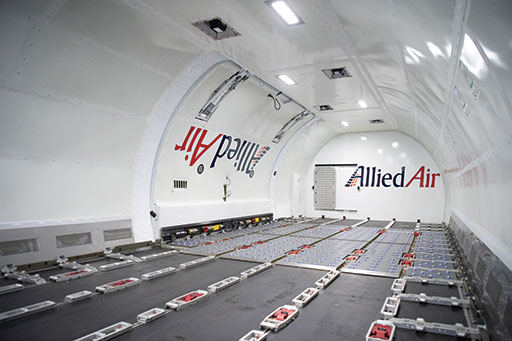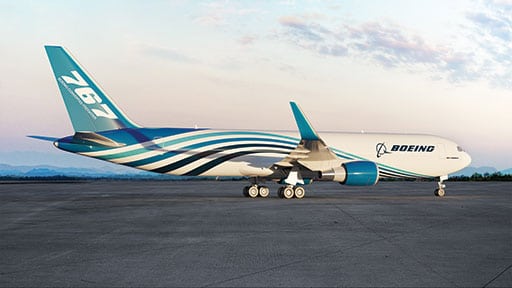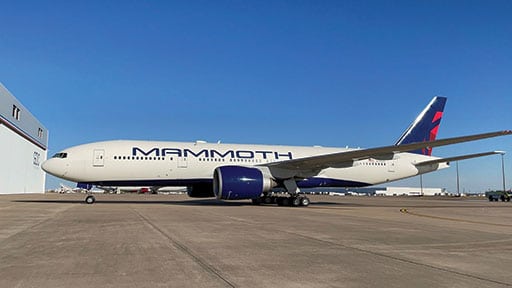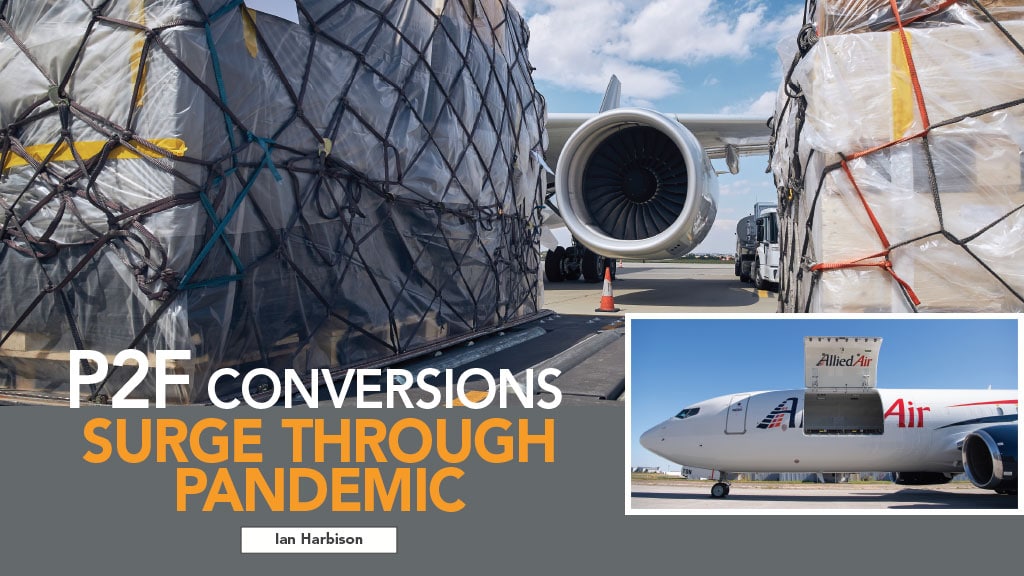One aviation sector to have reaped benefits from the COVID-19 pandemic has been the freight business. The initial flurry came from rapidly delivering urgently needed personal protection equipment and medicine, demands that were met by empty passenger aircraft flying belly cargo and then by various means of securing cargo in the cabin.
It then became clear that the already increasing amount of e-commerce was skyrocketing as people in lockdown became ever more used to ordering online. As the residual values of all those grounded airliners slowly ticked down, opportunities arose for freighter conversions on much younger aircraft than the traditional 20-year old veteran.

However, there is still a need for more freighters — IATA reported that, while capacity in February this year was 12.5% above February 2021 (8.9% for international operations) and above pre-COVID-19 levels, it still remains 5.6% below February 2019 levels.
AEI
Robert Convey, senior vice president – sales & marketing at Aeronautical Engineers, Inc. (AEI), reckons increased e-commerce demand has brought forward the market by about five years. The problem in the narrowbody sector is a lack of feedstock. His company specializes in the Boeing 737. He says all the 737-300/400 Classics that have been converted are in service and not changing hands, while there is very little feedstock left. That leaves the 737-800, for which there is a huge pool of aircraft and huge demand.
In 2019, AEI had received its STC and were working on two aircraft for GECAS and waiting for a third to arrive, while Boeing had had its STC for about a year and was doing just a handful of conversions. Feedstock was scarce because the aircraft were worth about $20 million and passenger demand was high. Once COVID-19 hit in March 2020, the passenger market dried up, with aircraft grounded and values starting to drop. As a result, the market for the 737-800 started picking up in May 2020 and AEI is booked out for around the next two years. It had already established a network of conversion partners and now has 10 dedicated -800 lines producing over 30 aircraft a year at five facilities (Commercial Jet Inc at Miami International Airport and Dothan, AL; HAECO Xiamen in China; KF Aerospace in Kelowna, Canada; and Taikoo (Shandong) Aircraft Engineering Company (STAECO) in China).
Until the summer of 2021, feedstock remained plentiful but then started tightening as more aircraft returned to passenger service and residual values climbed. Currently, prices are around $12 million but older aircraft are once again being converted. He expects this trend to continue for some time.
He adds that the aircraft that have been ordered over the last two years have not come from leasing companies disposing of assets, rather that companies like Aero Capital Solutions (ACS), BlackRock, GA Telesis and Macquarie AirFinance saw an opportunity to get into the project at an early stage craft using aircraft already in their inventory or bought on spec in the open market.
The U. S. and Europe are important markets, with the U. S. leading on the 737-800 as there is a significant fleet of 737-400s already operating in Europe. China is a small player, perhaps less than ten aircraft a year, as are Central and South America. Most of the customers are operating services on behalf of major shippers such as DHL.
A unique aspect of the AEI STC, developed at customer request, is that the belly holds have been converted to Class E compartments, with detection and depressurisation to combat fire. This enabled the AEI conversion to be ETOPS 180 approved and is currently the only conversion provider with this approval. It was used with immediate effect by Ethiopian Airlines, which used the aircraft on services across the Indian Ocean, although it also important given the lack of diversionary airports in much of Africa. Convey suggests Alaska and Hawai’i as other good examples where ETOPS can be used.
He says there is a balance to be struck on the levels of investment to be made in infrastructure. With Boeing charging ahead on its own 737-800 programme, he thinks there is too much capacity. With 80 aircraft to be converted by the industry in 2022 and an estimated 100 in 2023, he believes there will be a leveling off of demand starting in 2024.
While the focus is very much on the 737-800, the company also has its legacy conversions – the Bombardier CRJ 200, Boeing 737-300, Boeing 737-400 and McDonnell Douglas MD-80 – all of which are ticking over, with five lines. Aeronaves TSM in Mexico has six CRJ on order that will allow a line to run until the end of 2023. The last MD-88 order was in March 2021 for six aircraft for USA Jet Airlines (USA JET) and he says there is an engine corrosion AD that is making customers a little wary of adding to their fleets until that is resolved. While there is strong demand for the 737-400, there is simply no feedstock.
As a result, he expects the legacy products to fade away in a few years’ time. That would leave just the 737-800, so there are initial plans to look at another aircraft model to avoid dependence on a single type.
Boeing
According to Boeing’s most recent Commercial Market Outlook, we anticipate the global freighter fleet (production and conversions) will grow more than 70% from 2019, amounting to 2,610 new freighter deliveries in the next two decades. Of these, 890 will be production freighters and the remaining 1,720 will be converted freighters.
Specifically for freighter conversions, it is forecasting demand for 1,720 converted freighters over the next 20 years to replace aging freighters and accommodate future growth. This includes 1,200 narrowbody conversions and 520 widebody conversions.

It has 13 active conversion lines for the 737-800BCF. In China there is Boeing Shanghai Aviation Services (2), Taikoo (Shandong) Aircraft Engineering (STAECO) in Jinan (6) and GAMECO Guangzhou (3), plus single lines at COOPESA in Costa Rica (1) and at Boeing’s London Gatwick MRO facility in the United Kingdom.
Although the first COOPESA line opened only recently, it is already planned to add another, along with another line STAECO and two more at KF Aerospace in Canada. However, the company does not reveal production rates.
The first aircraft has just been inducted into the Gatwick facility. This will be delivered to Icelease, a Reykjavik-based leasing company by ASL Aviation Holdings (ASL). At the end of March, the company added 10 firm orders and 10 purchase rights for the 737-800BCF, taking its total orders and commitments to 40 aircraft. Some of the aircraft will also be converted at STAECO. Meanwhile, Texel Air in Bahrain, which accepted its first aircraft in January this year, has just added a further two.
At the end of April, STAECO completed its 50th conversion. The first aircraft for ICBC Leasing, it was delivered to Ethiopian Cargo. So far, a total of 75 aircraft have been converted globally.
For the 767-300BCF, it has three active conversion lines at ST Engineering in Singapore and one at GAMECO in Guangzhou, with another to be added at GAMECO and one at ST Engineering in Guangzhou.
The most recent transaction was in March, when ATSG announced that its leasing subsidiary Cargo Aircraft Management had placed a second order with Boeing for the conversion of four CAM-owned 767-300 aircraft, with an options for a further four. The conversions are scheduled to begin in late 2023.
EFW
Elbe Flugzeugwerke (EFW) has been a long-term player in the conversion market, dating back to 1996, since when it has produced over 200 Airbus A300 and A310 freighters. Now jointly owned by Airbus and ST Engineering, it is currently involved in A320, A321 and A330 P2F programs, with conversion sites in Dresden, Germany, Singapore and VT SAA in San Antonio, TX. This year, ST Engineering will open a new facility in Shanghai, China, while VT MAE in Mobile, AL, will join the program. It holds the STCs for all conversion programs.
Dresden is dedicated to the A330P2F, with six lines, while Singapore is focusing on the single aisle models. China and the U. S. will each have two lines, one for A320/321 and one for A330. The company says that, despite the recovery in passenger traffic, there is sufficient and suitable feedstock available for the three types.
By April, it had converted five A330-200P2F and 11 A330-300P2F, which have been in service since 2017, and seven A321P2F, which entered service in 2020. In March, the A320P2F received EASA STC approval. The prototype A320P2F is owned by the aviation leasing arm of ST Engineering and it will be the first of five to be leased to Vaayu Group. Delivery is expected in 2Q22 on sub-lease to Astral Aviation, based in Nairobi, Kenya.
In March, it signed a major deal with ATSG for 29 A330P2F. The conversions will run from mid-2023 through 2027, mainly at EFW’s facility in Dresden, Germany, but also in Shanghai and Mobile.
Mike Berger, CCO of ATSG, said: “The A330-300 passenger-to-freighter conversion is a natural next step for ATSG as it is an excellent complement to the Boeing 767-300 medium wide-body freighter, which has long been the freighter of choice for the e-commerce air cargo market. The customer response to the news that we will have A330-300 freighters available for lease has been exceptionally strong, and we already have customer deposits toward future leases for half of these 29 converted freighters.”
In February, CDB Aviation added 12 A330P2F aircraft, taking its commitment to 14 aircraft. Two months later, the first converted A330-300P2F was handed over on lease to Mexico-based mas. As the airline already operates an A330-200P2F leased from Altavair, delivered in January, it becomes the first to operate both types. The A330-300P2F will be operated mainly on routes to Europe, while the A330-200P2F will be operated on new scheduled routes to China, which will start before the end of the 1H22.
Such is demand that EFW is planning to increase production to 60 aircraft by the end of 2024, consisting of 31 A320/A321P2F and 29 A330P2F and it expects these types in future to dominate in both the narrowbody and widebody sectors. It does acknowledge that the pandemic has affected the supply chain, trained manpower and availability of hangar slots but says its global network gives it flexibility to cope with the situation.

Mammoth
A new entrant in the widebody sector is Mammoth Freighters. Set up in 2021 by industry veterans Bill Wagner and Bill Tarpley and backed by private investment funds managed by Fortress Investment Group, it has ten ex-Delta Boeing 777-200LRs as its initial feedstock. With a Boeing data licence, it also plans to convert 777-300ERs as well.
In September last year, it entered into a strategic partnership with GDC Technics to use the latter’s 840,000ft² facility at Alliance Airport in Fort Worth, TX, which has six widebody hangar bays and, in November, it announced that Cargojet Airways of Canada had become the launch customer with the signing of a sales agreement for two 777-200LRMF freighters, plus options for a further two -200LRMFs and two -300ERMFs.
Brian McCarthy, vice President marketing and sales, says the U. S. MRO industry is facing challenges with finding skilled labour, while wages are increasing, and GDC seemed a good choice of base, being in the middle of the country and well established. Eventually, up to 400 people could be employed at Mammoth, as the cargo doors and surround structures will also be built on site, ensuring tight control of the supply chain.
The plan is ramp up to four conversion lines in Fort Worth. After certification, two additional lines will be stablished at another North American facility. This should be followed by a facility in the Asia Pacific region and another in Europe or the Middle East.
He says selection of the 777 was not so much to do with dropping values as there being plenty of feedstock available. There have been plenty of lease returns, unrelated to problems caused by the pandemic, with many more to come – he reckons there are around 100 in the desert. While the situation has been helped by some -300s being parked a bit prematurely, he thinks this will tighten up eventually. Mammoth has enough feedstock until 2026, as does the industry as a whole.
The main reason for so much availability is the extreme cost of refurbishing the cabins. Transitioning an aircraft to a new customer can cost up to $15 million with upgrading IFE, introducing connectivity and in-seat power.
He says those people who moved quickly when they heard about the project and reserved slots are going to be the leaders in this fleet type.
At the moment, the tooling is arriving at Fort Worth to support the prototype aircraft (MSN 29742) during the conversion process. He says the company is less focused on the “ceremonial metal cutting ceremony” than on getting the interior prepared. It should look like a freighter at the end of 3Q22, when it will be presented to the FAA. Entry into serviced is predicted by Cargojet to be in late 2023 or early 2024.
Interest is coming from a wide range of operators. He points out that, for narrowbody conversions, people will wait patiently up to two years but, for widebody conversions, they tend to play a longer game, unless they are acquiring a large number of aircraft. This partly due to the amount of planning required to get such an aircraft into service, so the interest level extends to three to three and a half years. That means sales efforts are concentrated on slots in 2026.
With four lines at Fort Worth and three additional sites running two lines, production levels should be four aircraft per year per line. There will be a “bow wave” for the next few years before it settles down to a more normal level.
He comments that while plenty of parked aircraft is good for conversion feedstock, it is bad if they are parked too early. The burden of looking after aircraft in storage to the highest OEM technical standards is labour intensive and very expensive and will work for several years. However, longer than that, there will be deterioration and the cost of return to service is very high.
He adds that there is a possibility that operators waiting for new aircraft deliveries may postpone release or retirement of 777s until they get a clear picture of orders or, at the very least, a realignment of promised deliveries.
There are two widebody markets. The 777-300LRMF is ideally suited for the e-commerce and integrator industry because of its cargo density and payload. For governments, logistic companies and general cargo haulers, he feels that that there is a movement where nobody wants to get caught short of lift again, as happened in the pandemic, with the loss of billions of dollars. Having found themselves unable to get their products to market at a fair price, they are no longer willing to leave it to the airlines. They want to create relationships where they have a high degree of control over the aircraft.
This is perfectly illustrated by an agreement between DHL and Cargojet signed in March. Cargojet will provide ACMI, CMI, charter, and aircraft dry lease services to DHL’s international requirements for Europe and North, South, Central and Latin America, as well as Asia. The airline already utilizes 12 freighters to service DHL’s current requirements but will add five 767 freighters during the 2022-23. DHL intends to be Cargojet’s inaugural launch customer for the 777-200LRMF.
McCarthy says long range, high-capacity freighters with new generation engines with reduced fuel burn are the future, removing older gas guzzlers.
